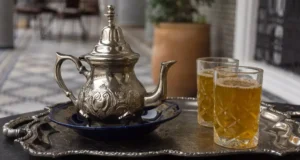5 Moroccan Foods You Must Eat
1.Tagine: The Heart of Moroccan Cuisine

Introduction
Tagine is a quintessential Moroccan dish, known not as it were for its interesting cooking strategy but moreover for its unimaginable flavors. Named after the pottery pot in which it is cooked, tagine can be made with a assortment of fixings, counting meat, vegetables, and fragrant spices.
Ingredients and Preparation
A conventional tagine regularly incorporates sheep, chicken, or hamburger, matched with vegetables like carrots, potatoes, and olives. The key to a extraordinary tagine is the spices—cumin, coriander, saffron, and cinnamon are commonly utilized. The cooking handle includes layering the fixings in the tagine pot, permitting the moderate cooking to merge the flavors together. This strategy holds dampness, coming about in delicate, juicy dishes.
Cultural Significance
Tagine is more than fair nourishment; it’s a image of Moroccan neighborliness. Regularly served communally, it energizes sharing and association among family and companions. Each locale of Morocco has its claim adaptation, displaying neighborhood fixings and culinary traditions.
2. Couscous: The National Dish of Morocco

Introduction
Couscous is a staple in Moroccan family units and is frequently considered the national dish. Made from steamed semolina wheat, it serves as a flexible base for a assortment of toppings.
Ingredients and Preparation
The planning of couscous includes steaming the semolina, which is frequently served with a wealthy sauce made from sheep, chicken, or vegetables. Common backups incorporate chickpeas, raisins, and a variety of flavors. The dish is customarily arranged on Fridays, taking after the week by week supplication, making it a extraordinary supper for families.
Cultural Significance
Couscous speaks to Moroccan culture’s accentuation on community and celebration. It’s frequently served amid extraordinary events, weddings, and social occasions, fortifying its status as a image of togetherness.
3. Pastilla: A Sweet and Savory Delight

Introduction
Pastilla is a special Moroccan cake that flawlessly equalizations sweet and savory flavors. Customarily made with pigeon, it’s presently frequently arranged with chicken or seafood.
Ingredients and Preparation
The dish highlights layers of flaky cake (regularly warqa, comparative to phyllo mixture) filled with a blend of spiced meat, almonds, and eggs. After preparing, it’s liberally cleaned with powdered sugar and cinnamon, making an eye-catching differentiate. The combination of flavors and surfaces makes pastilla a standout dish.
Cultural Significance
Pastilla is regularly served amid merry events, such as weddings and devout occasions. Its complex flavors symbolize the lavishness of Moroccan culinary conventions, exhibiting the impact of different societies that have formed the country’s gastronomy.
4. Harira: A Feeding Soup

Introduction
Harira is a conventional Moroccan soup, especially prevalent amid Ramadan. It’s healthy, flavorful, and pressed with supplements, making it the idealize dish to break the fast.
Ingredients and Preparation
This soup is made with tomatoes, lentils, chickpeas, and a assortment of flavors, counting cinnamon and turmeric. New herbs like cilantro and parsley include freshness. Harira can incorporate meat, such as sheep or chicken, and is regularly served with dates and bread for a total meal.
Cultural Significance
Harira is profoundly inserted in Moroccan culture, symbolizing warmth and neighborliness. It is regularly made in expansive clusters to share with family and companions, particularly amid Ramadan, strengthening the significance of community and sharing.
5. Mint Tea: The Moroccan Beverage

Introduction
Mint tea, known as « Moroccan whisky, » is a cherished refreshment in Morocco. It’s a image of neighborliness and is served in homes, cafes, and eateries alike.
Ingredients and Preparation
The tea is made with green tea, new mint clears out, and a liberal sum of sugar. The arrangement includes soaking the tea and at that point pouring it from a stature into little glasses to make a foamy beat. The tea can be balanced in sweetness and mintiness concurring to individual preference.
Cultural Significance
Serving mint tea is an critical social custom in Moroccan culture. It speaks to companionship and neighborliness, and the planning and serving of the tea regularly include expand methods. Sharing a pot of mint tea is a way to welcome visitors and cultivate connections.
These articles give a see into the wealthy embroidered artwork of Moroccan cooking, highlighting its differing qualities and social importance. Whether you’re savoring a healthy tagine or sharing mint tea with companions, each dish tells a story of convention and community. Appreciate your culinary travel!
Check out this post : https://buzzrival.com/thing-you-should-have-in-travel/
Check out our insta : https://www.instagram.com/bsm_kitchens_design/



